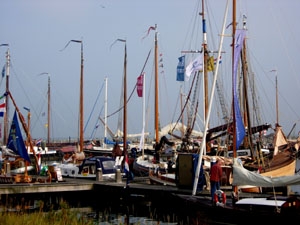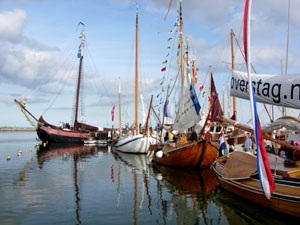Step
han Kraan©
Curriculum Vitae
Biografie
Producten
_________
Weblog
Genre
Onderwerp
_________
Links
Contact
Fotogalerij
Great variety at magnificent Dutch Classic Boat Show
Dit artikel is een verslag van de Beurs Klassieke Schepen 2005. De beurs was van 7 tot 9 oktober in Medemblik. Stephan Kraan maakte een online nieuwskrant voor de beurs inclusief foto's. Op grond hiervan is hij gevraagd een artikel te schrijven voor het Engelse tijdschrift Classic Boat. Het grootste in haar soort ter wereld. Het artikel verschijnt in het decembernummer 2005.
Great variety at magnificent Dutch Classic Boat Show
The biggest international Classic Boat Show of Europe was held in the old Dutch port of Medemblik on 7, 8 and 9 October 2005. Running for nine years now, the Show is growing every year. About 60 boats and 160 exhibitors were visited by 4000 lovers of traditional vessels. The Classic Boat Show covers the construction, management, maintenance and preservation of old sailing ships, towing boats and trade vessels. It even showed an Egyptian boat and a strange Viking ship made by a Dutch-American ice-cream enthusiast.
The morning fog hangs just a few metres over the water. When the fog lifts, the glorious masts pierce impressively into a blue sky. Walking along the floating landing stages, old wooden bows and classic iron bows appear side to side in the cold wet air. This is the most beautiful time of day to visit the harbour of the Classic Boat Show. The early morning, when everybody is sleeping and boats peacefully bobble up and down.
When the sun gets warmer and the fog is gone, the shapes of a big variety of vessels show why this event is so very popular. The maritime heritage of the Netherlands is rich and full of glory. Whether we look at the round shaped wooden fishing boats, the slender sailing clippers or the proud yachts –big and small-, we witness a long history of sailing, working on and fighting against the water. Then again; looking at the exhibitors and visitors, we see many brown-tinted skins and big hard-skinned hands. This is the show to be at for sailors, boat owners and craftsmen.
Besides the boats and ships in the harbour, the show featured an enormous covered market with an overwhelming amount of experts, craftsmen and charterers; a lot of information on keeping, restoring, building and buying boats; many rare and specific tools, boat parts, designs and accessories. Here boat builders exhibit their small hand-made ships, companies display engines, masts or even cushions and blankets. Where ever you look, people are searching for something special, talking about the latest developments or discussing boat problems while drinking their coffee.
Thedo Fruithof , the president of this Classic Boat Show, works the year round to contact all the exhibitors, do the publicity and update information on the very informative website www.klassieke-schepen.nl. Fruithof is the spider in the web when it comes to the traditional boat network in the Netherlands. He’s also co-founder of the European Maritime Heritage. During the boat show he is managing a big crew of professionals and volunteers. Thedo Fruithof is a friendly and remarkable man, dressed in a green smock and a traditional fisherman’s hat.
On Friday morning at eleven he blows on a big seashell that makes the sound of a low foghorn. It’s the sign for all to gather for the official opening speech. Fruithof meandered into the history of the boat shows and lists the highlights of this year. The delegate of the Province of North Holland, Mr. Patrick Poelmann, addressed the importance of the big fleet of clippers, tjalks and other traditional sailing ships of the former Zuiderzee harbours. He looks back at the big ‘Sail 2005’ tall-ship event in Amsterdam last summer which was partly sponsored by the Province of North Holland. They devoted special attention to young people and organized a sailing race on the tall ships with half of the crews being kids. It’s very important that young people become interested in traditional sailing boats and he hopes to see many of them at the boat show.
Well, there were many young people among the big variety of visitors. The Sail Training Association Netherlands received a lot of attention with an impressive movie about the Tall-Ships Race. “We want to teach young people about the sea and to show them how much more fun it is to work hard on a sailing vessel than to sit in front of the TV,” said Diederik Ramswinckel of STAN. “We want youngsters back on the waves.” STAN mediates between schools and sponsors. STAN is part of an international organisation now listening to the name Sail Training International (STI).
It seems a good choice of Thedo Fruithof to also focus a bit on the younger generation. The nautical college and the wooden-boat college both from the nearby harbour Enkhuizen were present at the show. It’s necessary to attract youth because most traditional maritime crafts are done by older –mostly- men. These men however with all their experience and their life stories are very interesting and much can be learned from them.
Like there is boat-builder, Piet Kraakman, who lives in the area of Medemblik called West Friesland. The slender gray haired man in his blue overalls was present at the quayside of the Boat Show. Visitors were all eyes and ears. He cuts thin iron in a manual cutting machine. With a big smile the aged man narrated the story of a special gift.
One day somebody brought him the wreck of an old canoe-type rowing boat. It was made of thin steal and wood and used up to 1950 on the canals by hunters, fishermen and poachers and also by horticulturists who used them for their speed. The boat is called Giek and it is very rare. Only a few of them still remain.
Kraakman wanted to keep it as a model and tried to hoist it into his attic. But it fell and the tip broke. He first repaired it but a new tip on a wreck didn’t look right. So he restored the whole boat. At the show he displays the result and the Giek outshines in simplicity and grace.
The Classic Boat Show is not only about old vessels. You could find newly built wooden boats that are replicas of the 17 th century round- and flat-bottomed ships or modern yachts shaped like old tug-boats and steel fishing boats under sail. A good example of a traditional modern ship is the Zeeuws Waterschip, from the south-west province of Zeeland that has quite a story to it. Erik Römelingh wanted his friend Lars Kosse to build him a wooden boat. Lars found an old painting of an extinct boat type on an old delft-blue tile. Later he found a few little paintings with this ship in it in a museum in Antwerp, Belgium. It is a Zeeuws Waterschip used between 1610 and 1850. The ship left the dunes of Zeeland with fresh water and food to supply the fishing boats on the North Sea and returned to the beach with the fish. This way the fishing boats could go on fishing.
Boat-builder Kosse built it as a traditional ship but in the front part tall enough to stand upright and there is a little kitchen and a toilet. So a family can sail in the traditional way and enjoy a little modern comfort as well. By the way, the skin of the trunk is fixed to the frame with 14,000 wooden pins.
This Zeeuws Waterschip looks a bit funny among the other boats at the show because it rises high up out of the water. Kosse: “That’s because it’s not finished yet. When the ballast is built in, the boat will lay deeper and straight.”
The replica is the only Waterschip in the Netherlands.Building replicas is popular in the province of Friesland. At the moment three projects are carried out by different traditional shipyards to build wooden boats that are extinct. The old village of Moddergat is situated in the North behind the dike of the Waddenzee. The local museum shipyard ‘It Fiskerskip’ is building a vessel called Wierumer Aek, a Schokker-type ship, used for fishing on the Waddenzee. Inland there is a project in the middle of an area with lakes and moors. At the dock of the Skûtsjemuseum in the village of Earnewoude a wooden skûtsje is being built. Skûtsjes were used for transportation on the canals. The flat-bottomed boats transported peat and potatoes from the farmers to the cityfolk. In the village of Heeg, the keel will be laid for an original Palingaak this November. For three centuries these boats were sailing to London with live eel, 20,000 tons per vessel. It was very important for London; Heeg even had free and private anchorage. In 1946 the last ship was sapped. All three projects were to be seen at the Boat Show as De Driewerf.
The town of Fecamp in French Normandy restores a Breton wooden fishing boat called Michèle et Patrick. The ship was built in 1973. It a social project with European money to teach unemployed people how to do carpentry and how to take up other skills. At the Boat Show ten of them worked on wooden steering-wheels and helms. Their tools drew a lot of attention. The Belgium town of Oostende had already built the Twomast Sloop Nele, used for fishing on the North Sea, and it was launched on May 7th, 2005. It was one of the beauties in the harbour of the Boat Show. In the exhibition hall Oostende showed a big skeleton model to promote the annual maritime festival ‘ Oostende voor Anker’, where hundreds of boats gather.
There were some peculiar foreign boats. Rob McDonald is an American who lives in the Netherlands. He attended the boat show with a Viking-ship built out of 15 million ice-cream-sticks. He wants to sail the ocean from the Netherlands to Canada following the old Viking routes. The project was founded to sponsor children hospitals all over the world. In the centre of the harbour another stranger was floating. It’s an Egyptian tomb boat, built by the Dutch cabinetmaker Floris Barends, who has a life-long passion for Egypt and realized a dream with this perfectly rafted an decorated boat.
The 160 exhibitors of the Boat Show were very diverse: modern shipyards, ship agents, timber merchants, insurance companies, maritime publishing companies, associations of ship types and crafts, charterers, ship designers, boat builders, producers of blocks, masts, paints, engines and artists. Everything you can imagine when it comes to classic boats gatherings in Medemblik. Most of the companies were Dutch as there are thousands of these traditional boats sailing here. But there were also exhibitors from France, Germany and Belgium.
In previous editions of the show companies and ships of Great-Britain were present as well. This year the UK was only represented by John Robinson of the European Maritime Heritage.
“It’s difficult to convince English companies that they can do business here. The traditional maritime market at home is kind of locked”, John Robinson explained. He is at the Boat Show in the Netherlands to see what the Dutch can contribute to the British market. Robinson enjoyed himself walking around the sunny harbour, taking pictures of the ships. He was very exited about the tjalk, De Bruinvisch, built in 1902. In an earlier life the ship transported peat, shells, potatoes, manure and timber. Skipper Cees Dekker is sailing it as a charter since 1980. He restored the ship back to its origin using the same materials as they would have a hundred years ago. The Bruinvisch is officially recognised as a sailing monument. It caught the attention of Robinson because of the heavy rhythmic pounding sound of the engine, a 1 cylinder 30 pk Kromhout from 1917. John Robinson climbed on board and had a long talk with the skipper about the engine and the history of the ship. A very special story was a new one. When the Bruinvisch entered the harbour of Medemblik to attend the Boat Show, he found a place in front of another tjalk. It was the brand new Idefix. From a distance the old and the young boat had something in common. The same lines, the same shape and the same size. No wonder. The owner of the Idefix built the new tjalk from the drawings for the Bruinvisch, which were printed in its centennial jubilee book.. This news was a surprise to everyone.

A few other anniversaries were celebrated at the Boat Show. The oldest association on traditional boats in the world is about Dutch round- and flat-bottomed boats (SSRP). This year the association celebrated its 50th year in August with a reunion of 220 wooden ships. Twice as old is the insurance company Oranje, specialised in the maritime branch. A hundred years ago the company was founded by skippers of tjalks which often sailed to Denmark at that time. The insurance company covered the risks. The oldest celebrator at the Classic Boat Show was shipyard Van der Meulen, founded in 1880. They had a party with 70 wooden boats, listening to beautiful names as boeiers, schouwen, Friese jachten and Hoogaars. The Frysian Maritime Museum has a special exhibition on the 125 year old shipyard.
Organizer Thedo Fruithof was very satisfied at the end of this 9th Classic Boat Show. The weather had been sunny; the atmosphere was friendly and the turn out great. This year’s show was bigger and had more variety than ever. “I think we have to do a special boat show next year, for our tenth anniversary,” Thedo Fruithof said. “Yesterday a boat association came up to me and told me he wants to bring ten boats instead of one, just because of the celebration.”
| home | weblog | curriculum vitae | artikelen | producten | links | contact |

